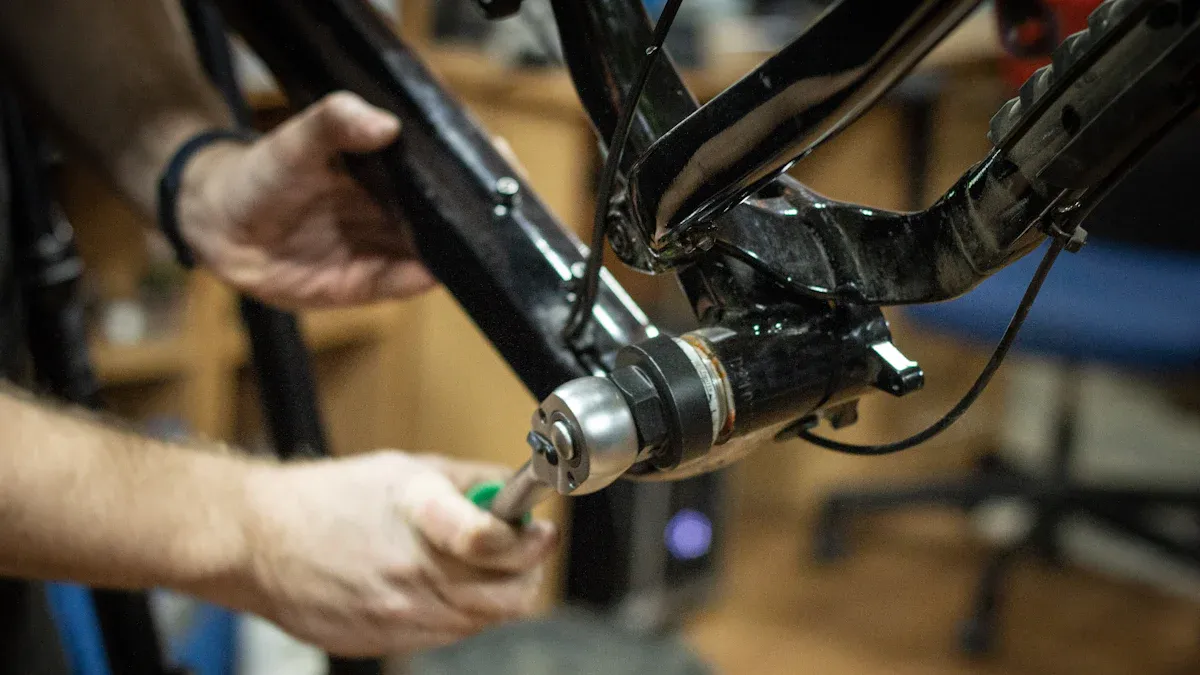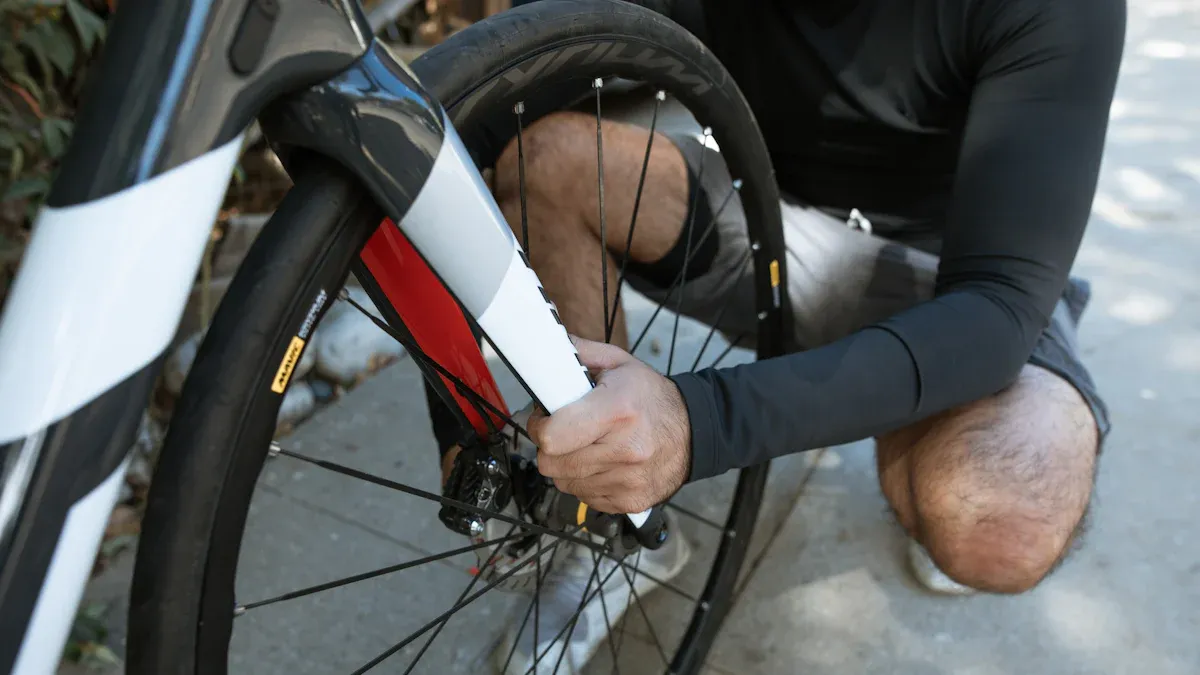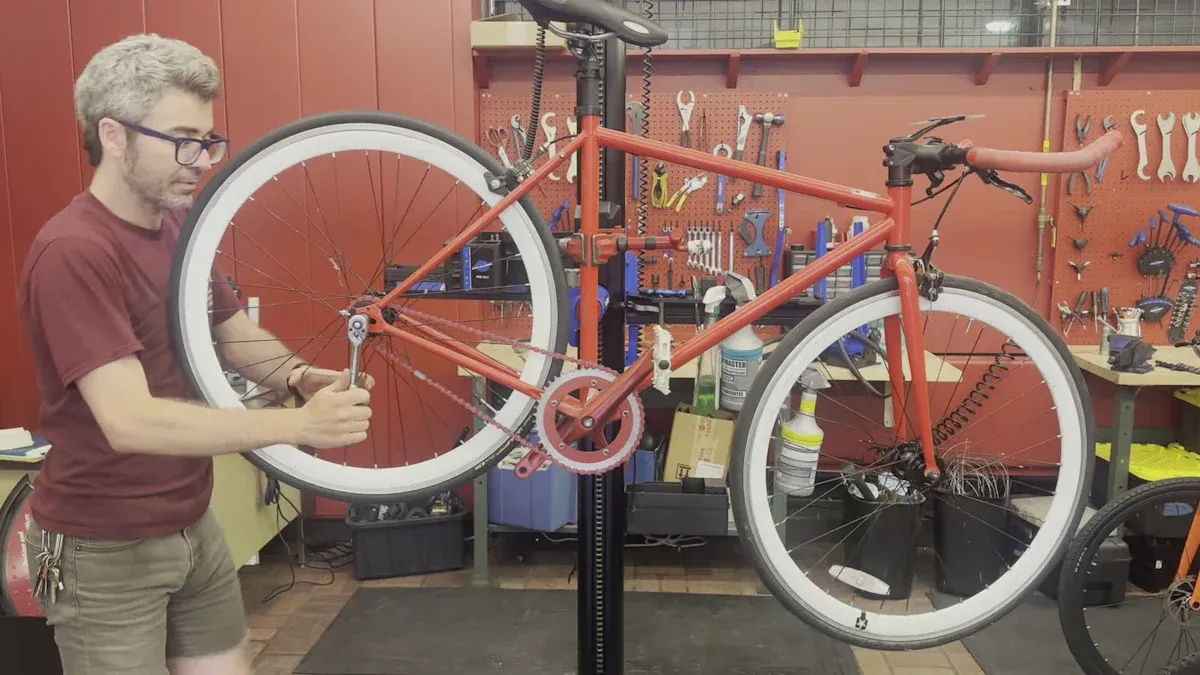
You love your bike, so you want to keep it looking sharp. Scratches and dings can happen fast, but bike frame protection helps stop them in their tracks. > Bike frame protection matters whether you ride on city streets or rocky trails. Start protecting your bike frame today.
Key Takeaways
Protect your bike frame so it does not get scratched. This helps keep your bike worth more money. It also makes your bike last longer. Use films, tapes, or guards on places like the downtube and chainstays.
Pick bike frame protectors that match your bike type. Think about how you ride your bike. Make sure the protector covers the right spots. Choose strong materials that last a long time. Pick protectors that are easy to put on.
Keep your bike frame protectors clean all the time. Check them often to find damage early. Change them when they get worn out. This keeps your bike safe for a long time.
Why Bike Frame Protection Matters

Preventing Scratches
You want your bike to look great every time you ride. Scratches and damage can happen fast, especially if you ride on rough trails or busy streets. Bike frame protectors help shield against gravel, rocks, and daily knocks and scrapes. When you use protectors, you stop paint chips and dents before they start.
Carbon fiber and aluminum frames can hide cracks that lead to sudden failure.
Metal frames usually show cracks, but they still need protection from impacts.
Poor design or bad maintenance can make damage worse.
Bike frame protection gives you peace of mind, no matter what type of bike you ride.
Preserving Value
If you ever want to sell your bike, you know buyers look for a clean, well-kept frame. Bike frame protectors keep your bike looking new by blocking scratches and damage from rocks, debris, and other hazards.
A bike with frame protection holds its value better because it looks good and works well.
Protectors help you avoid costly repairs and keep your bike’s resale price high.
Improving Longevity
Bike frame protection does more than just keep your bike pretty. Protectors absorb impacts and reduce wear from regular use.
Downtube protectors guard against chips and scratches from flying rocks.
Protectors add a layer that keeps your frame safe from outside damage.
Many cyclists say their bikes last longer when they use protectors.
When you use bike frame protectors, you extend the life of your bike and spend less time worrying about repairs.
Best Bike Frame Protectors
If you want your bike to look new, you need good bike frame protectors. There are many choices, so let’s see what works for different needs and budgets.
Protective Films
Protective films are a popular way to protect your bike frame. These films use strong materials like thermoplastic polyurethane to make a tough shield. They keep away scratches, chips, and small hits. Some films, like RideWrap’s Lotus Pro™, use recycled stuff and cover almost the whole frame. These films can fix small scratches by themselves if you use a little heat.
Paint Protection Film (PPF) is special because it spreads out the force from rocks and debris. This means your frame gets less damage, so you worry less about chips. PPF also keeps away bird droppings and tree sap, which can hurt your paint. If you ride on gravel or rough trails, you will see the difference.
Here is a table with some of the best bike frame protectors:
Brand | Key Features and Popularity Highlights |
|---|---|
All Mountain Style Frame Guards | Durable, stylish, favored by mountain bikers |
3M Scotchgard Paint Protection Film | Transparent, durable, popular among road cyclists |
DYEDBRO Frame Protector | Customizable designs, allows personalization |
Lizard Skins Frame Protector | High protection for critical frame areas like down tube and chainstay |
VeloSkin Premium Bike Frame Protector | Sleek finish, high durability, reliable protection without style loss |
Tip: Put protective films on the downtube, top tube, seat stays, and fork blades for the best results.
Clear Tapes
Clear tapes are another simple way to protect your bike. Many riders use frame protection tapes like helicopter tape or Shelter Tape. These tapes are easy to put on and fit most frame shapes. Lizard Skins uses a clear film that is thicker, so it gives more protection. AMS Honeycomb Frame Guards use tough PVC, which is thick and stiff, so it is easy to put on without bubbles.
Some tapes, like Effetto Mariposa’s Shelter tape, are even thicker and can take hard hits. This makes them great for carbon frames or bikes that get used a lot. RideWrap has a special film that looks almost invisible and can fix small scratches by itself.
You can use clear tapes where cables rub, around the seatpost, or on the head tube. These spots often get scratched by bags, cables, or your knees.
Frame Guards
Frame guards give extra protection to the places that get hit the most. You can find frame guards made from strong stuff like carbon leather or thick rubber. Lizard Skins is known for its Carbon Leather and Frame Kit protectors. These are easy to put on and take off, and they protect the bottom bracket, chainstay, and downtube well.
Frame guards are tested in labs to make sure they can take hard hits. They use strong frames and safety guards to keep things safe during tests. This means you can trust these protectors to keep your bike safe from rocks and bumps.
Here are some common places to use frame guards:
Drive-side chainstay (where the chain hits)
Underside of the downtube (for gravel and mountain bikes)
Spots where brake or shifter housing rubs
Fork blades and seat stays
Note: Heavy-duty frame guards are best for mountain bikes or bikes that go on rough ground.
DIY Solutions
You do not always have to buy the best bike frame protectors. Sometimes, you can make your own. Old inner tubes work well as chainstay protectors. Just cut a piece and wrap it around the chainstay to stop chain slap and scratches. Nail polish can cover small scratches and keep them from getting worse.
Some riders use contact paper or electrical tape for quick fixes. You can also use Gorilla Tape or old tires for extra padding under the downtube or bottom bracket. These DIY ideas may not look fancy, but they still protect your frame.
Here are some DIY ideas:
Old inner tubes for chainstay protection
Nail polish for small scratches
Contact paper or electrical tape for cable rub spots
Gorilla Tape for extra padding
Remember: Always check your DIY protectors to make sure they stay in place and do not trap dirt or water.
No matter what you pick, the best bike frame protectors help your bike look good and last longer. You can use different protectors to cover all the spots that need it. When you use frame protection tapes, films, or guards, you feel better and your bike stays in great shape.
Choosing Bike Frame Protection
Bike Type
You want bike frame protectors that match your bike. Road bikes and hardtail mountain bikes have long, skinny tubes. Some kits, like the Covered Protection kit, fit these shapes well and protect about 60% of your frame. If you ride a mountain bike or a bike with a unique shape, you might need a tailored full wrap for full coverage. Think about where you ride. If you hit rocky trails, you need more protection than someone who rides on smooth roads.
Coverage Needs
Ask yourself how much coverage you want. Full kits protect every part of your bike, but they cost more and take longer to install. Partial kits focus on high-risk spots like the downtube and chainstay. Here’s a quick look at coverage options:
Kit Name | Coverage Type | Coverage % | Best For |
|---|---|---|---|
Covered Protection Kit | Universal, partial | ~60% | Road, hardtail bikes |
Tailored Full Wrap | Full coverage | 100% | Any bike, max protection |
Lizard Skins Frame Protector | Pre-cut, partial | Varies | Most frames, easy install |
Tip: If you want a good bike frame protector for everyday use, partial kits work well and save time.
Material & Durability
You want bike frame protectors that last. Polyurethane film is the most common. It’s tough and flexible, but can be tricky to install. Carbon fiber protectors are strong and light, but cost more. Vinyl is easy to use and cheap, but doesn’t last as long. Here’s a table to help you compare different types of bike frame protectors:
Material | Durability | Easy to Install | Cost |
|---|---|---|---|
Polyurethane Film | Very durable | No | Medium |
Carbon Fiber | Super strong | No | High |
Vinyl | Less durable | Yes | Low |
If you want long-lasting performance, choose polyurethane or carbon fiber.
Installation Ease
You want to spend less time installing bike frame protectors. Partial kits and pre-cut protectors go on fast and cover the spots that matter most. Full wraps take longer because you need to cover every part of your bike. DIY rolls like helicopter tape let you choose where to protect, but you need some skill to cut and fit them. If you want quick results, pick a kit that matches your bike’s shape and needs.
Remember: Full coverage gives the best protection, but partial kits save time and money.
Tips for Protecting Your Bike Frame
Cleaning Regularly
You want your bike to look great and last longer. Start by checking your frame for cracks or scratches before you clean. Use soft brushes or microfiber towels to brush off dirt. Skip high-pressure water sprays because they can push water into seals and wash away grease. Try a gentle spray from a garden hose or just use a damp cloth if your bike is not too dirty. Mix mild soap with warm water and use a spray bottle to clean the frame. Wipe everything down with a soft cloth, paying attention to tight spots near the bearings and drivetrain. Spray polish on a rag and rub it on the frame for extra shine, but keep it away from the brakes. Dry your bike with a clean towel to stop water spots.
Applying Protectors
You want to install bike frame protectors the right way. Clean and dry the frame before you start. Cut the films or tapes to fit the shape of your bike. Press them down slowly to avoid bubbles. Use your fingers or a soft cloth to smooth out the edges. Put protectors on the downtube, toptube, chainstays, seatstays, and spots where cables touch the frame. These areas get the most wear from rocks, debris, and cable rub. If you ride on rough trails, add extra guards to the chainstay and bottom bracket. Check your protectors often and replace them when you see damage or peeling.
Avoiding Common Mistakes
You want to avoid mistakes that lead to damage. Don’t rush when you clean or install protectors. Always use soft brushes and gentle cleaners, especially on carbon frames. Never use harsh chemicals or rough towels. Don’t forget to check high-risk spots like the seatpost, handlebars, and cable entry points. If you see scratches or chips, fix them fast with nail polish or new protectors. Regular checks and careful cleaning help you keep your bike safe and looking new.
Quick tip: Focus on the downtube, chainstays, and cable rub spots. These zones need the most protection to stop damage before it starts.
Maintaining Bike Frame Protectors

Inspecting for Damage
You want your bike frame protectors to work well every ride. Make quick checks before you hop on your bike. Focus on spots like the chainstays and head tube. Look for peeling, cracks, or loose edges. Every few months, take a closer look. Remove some parts if you need to see hidden areas. Once a year, let a bike shop check everything. This way, you catch problems early and keep your bike safe.
Do a quick check before every ride.
Look closely every three months.
Get a pro check-up once a year.
Tip: Early inspections help you spot small issues before they turn into big problems.
Cleaning Protectors
Keep your protectors clean to help them last longer. Use a soft, damp cloth to wipe away dirt and dust. Stay away from pressure washers because strong water can lift the edges or weaken the glue. Choose gentle cleaners like ProGold’s Bike Wash or Super Bike Wash™. These products work on all frame types and do not harm the protector or your bike.
Product Name | Safe for Protectors? | Key Features |
|---|---|---|
ProGold Bike Wash | Yes | No harsh chemicals, safe for all materials |
Super Bike Wash™ | Yes | Biodegradable, no rinsing needed |
Note: Never spray cleaner on your brakes or tires.
Replacing When Needed
Sometimes, protectors wear out. Watch for these signs:
Tears, holes, or loose threads
Parts of your bike showing through
Mold, dirt, or bad smells
If you see any of these, it is time for a new protector. Good maintenance means you always ride with strong, clean protection.
You can keep your bike in top shape with a little effort.
Proactive protection shields your frame from scratches and chips.
Regular checks and cleaning help your bike last longer.
Experts say these steps save money and boost performance.
Ride with confidence and enjoy every mile!
FAQ
How often should you replace bike frame protectors?
You should check your protectors every few months. Replace them when you see peeling, cracks, or damage. Fresh protectors keep your bike safe and looking new.
Can you use regular tape instead of special bike frame protectors?
You can use regular tape for quick fixes. Special bike frame protectors last longer and give better protection. Choose the right product for your riding style.
Where do you need the most protection on your bike frame?
Focus on the downtube, chainstays, and spots where cables rub. These areas get the most scratches and chips. Protecting them helps your bike stay in great shape.
See Also
Simple Tips To Use Bike Frame Charts For Comfort
How To Determine The Perfect Bike Frame Fit
Best Electric Bike Frame Materials And Their Benefits
